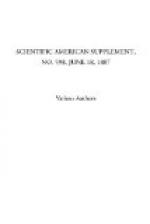[Illustration: Fig. 5. & Fig. 6.]
The ancient fallacy that small slip meant a high screw efficiency was supported by the great authority of the late Professor Rankine. Experience proved that considerable slips and efficient screws were companions. The late Mr. Froude offered an explanation of this general rule in a paper read before this Institution in 1878, and gave a curve of efficiency with varying true slip. In Mr. R E. Froude’s paper last year there was a form of this curve, with an arbitrary abscissa scale for the slip, devised to illustrate in one diagram the wide conditions covered by his experiments. In the screws now under consideration, the values of the pitch/diameter vary only from 1.2 to 1.34, and for these the abscissa values for the same slips do not differ much. Taking the mean value, and bringing the slips to a common scale, Fig. 5 is obtained, which would approximately represent the relation between the efficiency of any one of these screws and its true slip, if this curve were applicable to full sized screws propelling actual ships. The slips in Fig. 5 being real or true, are not the slips of commerce, which are the apparent slips, such as those given in the table. Let us endeavor to split up these real slips into the apparent slips and another item, the speed of the wake. We then at once meet with the difficulty that the wake in which the screw works has not a uniform motion. Complex, however, as are the motions of the wake, the screw may be assumed to work in a cylinder of water having such a uniform forward velocity as will produce the same effect as the actual wake on the thrust of the screw. It is then readily seen that the real slip is the sum of the apparent slip and the speed of the hypothetical wake. To make this clear, let V be the speed of the ship, Vs the speed of the screw, i.e., revolutions x pitch, and V the speed of the wake; then—
Apparent slip = Vs — V.
Real slip = Vs — speed
of ship with respect to the wake.
"
= Vs — (V — V) = (Vs — V) + Vw.
"
= Apparent slip + speed of the wake.
If the apparent slip be zero, the real slip is the speed of the wake, and if the apparent slip be negative, the real slip is less than the speed of the wake. The real slip is greater than the apparent slip, and can never be a negative quantity. From Mr. Froude’s model experiments, it appears that this speed of wake for the A class of ship amounts to about 10 per cent. of the speed of the A screw. If this value is correct, then the real slip is (10 + 17.6) per cent., or 27.6 per cent. This is shown in Fig. 6, where O is the point of no slip, being 17.64 from the point of real slip. Slips to the right of O are positive apparent slips, slips to the left are negative apparent slips. The vessel F would certainly have a wake with a speed considerably less than that of A’s wake. From the model experiments, the wake for F is about one-half that for the A class, or, roughly,




